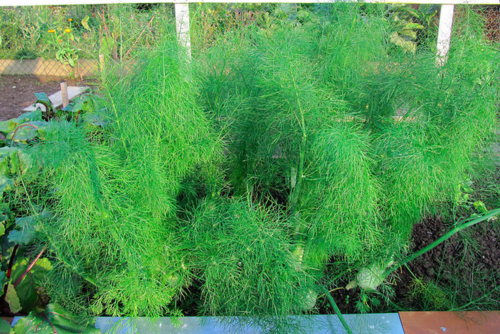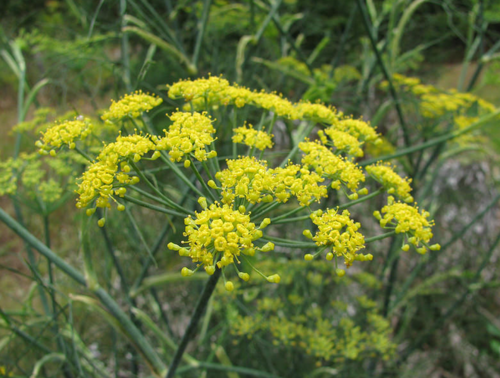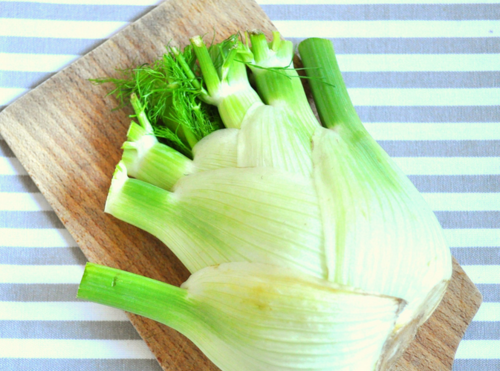
Fennel (Foeniculum vulgare)) is an aromatic herb which is both hardy and perennial. It is a member of the carrot family (Umbelliferae).[1] It is easy to grow, so much so that in some places it takes on a weed-like quality. It is easy to grow and has been cultivated since ancient times, including by the Romans.[2] The whole plant is edible, including its seeds and roots.
Once the plant is in place, it will self-seed with ease, so bear this in mind when planning your herb garden space.
Description[edit | edit source]
Fennel has feathery, light leaves that are very fine. They are light green initially, turning dark green as summer ends and autumn arrives. There is also a bronze version that has darker leaves at all times. The leaves are aromatic. It resembles dill in some respects but has thicker, coarser leaves.
The stem is round and solid and appears a shiny dark green in colour.

The plant has flowers in the middle of summer. These are small clusters that form in a circular head, and the flowers are bright yellow in colour.
The rootstalk is bulbous and makes an ideal vegetable, with layered sheaths.
The plant can grow to almost 2 metres (6 to 7 feet).[3]
Growing fennel[edit | edit source]
Fennel prefers a site that has full sun. Without full sun, its seeds will not ripen.[2] It prefers soils that are dry, well-drained and free of clay.[2] Choose soil that is sandy, crumbled loam.[3] If the soil is rich enough, fertiliser will not be needed––feed in plenty of well-rotted organic materials.[3] Lime may useful, as fennel prefers alkaline soil.[3]
Sow fennel seeds in late spring/early summer. The seeds can be sown in autumn in frost-free areas.[3] Sow to a depth of around 6mm (1/4 inch).
When the seedlings are strong, thin them to about 30cm/12 inches to 50cm/20 inches apart. The advice on this differs, so experiment for your own needs, but if you have plenty of space, err on the side of more space than less for the plants.
If you want stronger leaf production, remove the seed heads as the plant is growing.[2] If you do this, do not expect to get more seeds. It can be useful to grow some fennel plants for food and some for seed.
Ensure that the plant is consistently well watered during the warmer months, as this ensures the growth of a sweet and succulent plant.[3]
If the soil is poor and you need to add fertiliser, use a complete plant food in early spring.[3] Only do this once.
Harvesting[edit | edit source]
You can pick when the young stems and leaves are sufficiently formed, during the growing season. At the end of the season, the bulb is ready to be dug up and used as a vegetable. Before digging up the bulb, be sure to collect the ripe seeds and keep them for your next fennel crop. The seeds are usually ready in late summer.
If keeping the seeds, store in an airtight container with a label and date on it.
Cautions[edit | edit source]
Some things to consider when growing fennel include:
- Do not sow fennel near dill. The two plants can cross-pollinate.[2]
- Do not sow fennel near coriander, as coriander has the effect of reducing fennel's seed production.[2]
- The plant spreads quickly. You will need to keep it under control in the garden.
The plant does not have many problems with growing.
Uses[edit | edit source]
This herb has culinary, medicinal, cosmetic, decorative and gardening display uses.
Culinary[edit | edit source]

All of fennel has an aniseed flavour, so you must enjoy this flavour in order to truly enjoy fennel.
The seed can be added to sauces, salads, breads and fish dishes/soups. Fennel seeds are a common ingredient in bouillabaisse.[4]
The leaves can be added to salads and cooked vegetable dishes. Be sure to chop it finely and sprinkle over the food. Fennel goes well with pasta or potatoes.[3] The leaf sheaths can be cooked like leeks, such as in fennel à la Niçoise.[4] The leaves must always be used when fresh -- drying them causes flavour loss. However, leaves can be wrapped and frozen for up to six months.[3]
Freshly picked flowers can be used as salad decorations and goes well with sliced tomato and basil.[4]
The stem can be added to salads but only if it is young and fine. Chop into small pieces.
The bulb can be cooked as a root vegetable. It can also be finely chopped and used in salads or sandwich fillings.[2]
Medicinal/cosmetic[edit | edit source]
Fennel seeds can sweeten bad breath.[2]
The plant can be used as part of cleaning the face and skin.[2] Refer to appropriate instructions for such use. A cold fennel tea can be used on the face as an aid to tone the skin.[3]
Fennel seeds can assist digestion when chewed or used in a recipe.[3] A fennel tea can be a mild laxative.[3]
Fennel oil has use in the perfume industry.[4]
Be careful of some of the older myths surrounding fennel's medicinal uses, most of them are little more than myths. Do your research first!
Garden display/decorative[edit | edit source]
Fennel is a highly decorative plant and makes a lovely border plant. The flowers add beauty to the garden during summer and attract pollinating insects.
Sources and citations[edit | edit source]
- Sarah Baker. (2003) Herbaceous. ISBN 1-74045-219-4
- Lesley Bremness. (1992) The Complete Book of Herbs: A practical guide to growing & using herbs. ISBN 0-86438-066-6
- Magna Leth. (1976) Herbs how to grow and use them. ISBN 0-245-52848-2